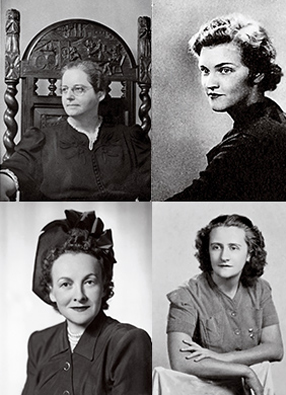
Story was updated in March 2022.
1925: The "college mother" to hundreds of young ladies and a few men, too, Mary Louise Brown served as dean of women from 1925 to 1944. AU's first female dean lived in the Women's Residence Hall for 17 years, "sharing the problems of all the girls who lived with her," before moving to a home of her own in nearby Bethesda in 1941. A graduate of DePauw University and the University of Michigan, Brown was an avid traveler and ravenous reader; she taught in AU's English department before retiring in 1947 to scratch her "itching heel." The Woods-Brown Amphitheater is named for Brown and CAS dean George Woods.
1934: As the first female editor-in-chief of the then American Eagle, Ann Henderson was known for "getting more done in a square minute than anyone else." Under her leadership, the student rag received an honorable mention from the Virginia Intercollegiate Press Association. Henderson settled in Chicago after graduation, married, and had four children. She also wrote and edited "What Every Woman Knows . . . and What Every Man Reads" for the Women's Association of the Union Church of Hinsdale, Illinois. Henderson published the newsletter from 1964 until her death in 2000.
1939: Helen Miller is a trailblazer twice over: she served as AU's first female student government president and the first woman editor of the Aucola yearbook. After graduation the go-getter, who also started on the women's basketball team, worked as director of public relations at AU for a year before enrolling at Syracuse University. She served in the Red Cross during World War II, holding posts in Australia and the Philippines, and was president of the AU alumni association from 1953 to 1955.
1950: Virginia Hawke became the head of the women’s division of the physical education department, beginning 27 years in leadership at AU. Hawke coached field hockey, tennis, volleyball, and women's basketball and founded the Metropolitan Intercollegiate Sports Association for Women, which created a network for DC area athletics programs. Hawke was honored for her trailblazing efforts when she became the first woman inducted into the university's Stafford H. "Pop" Cassell Hall of Fame in 1994.
1957: After earning her doctorate from AU in 1933, Catheryn Seckler-Hudson launched a nearly 30-year career at the university. She served as a professor of political science and public administration; chair of the Department of Government, Graduate School from 1934 to 1938; and chair of the political science and public administration departments. In 1957, she was named dean of the School of Government and Public Administration (now the School of Public Affairs), becoming the first woman to hold that post at any AU school or college. A student achievement award is named in Seckler-Hudson's honor.
1972 and 1980: Lee McGee and Mindy Portnoy, became the first women to serve as chaplain and rabbi at the university, respectively, in 1972 and 1980. McGee's tenure spanned 1972–1980. She was one of the “Washington Four” women ordained to the Episcopal priesthood at the Church of St. Stephen and the Incarnation in 1975, before the church’s authorization. Portnoy was also the university’s first full-time rabbi and spent fives years at the helm of AU's Hillel Foundation.
2017: Sylvia Burwell is AU's 15th president—and the first woman to hold the post. She came to AU after a distinguished career in government and philanthropy. Burwell held two cabinet positions under President Barack Obama, leading the Office of Management and Budget and later the Department of Health and Human Services—the second and fifth women, respectively, to serve in those roles. Burwell navigated a government shutdown, the implementation of the Affordable Care Act, and the global Ebola and Zika crises. Burwell, a Rhodes Scholar, also held leadership roles at the Bill and Melinda Gates Foundation and the Walmart Foundation. Under her leadership, the university has unveiled a transformative strategic plan, lanched the Change Can’t Wait campaign, and become the first university in the US to achieve carbon neutrality.